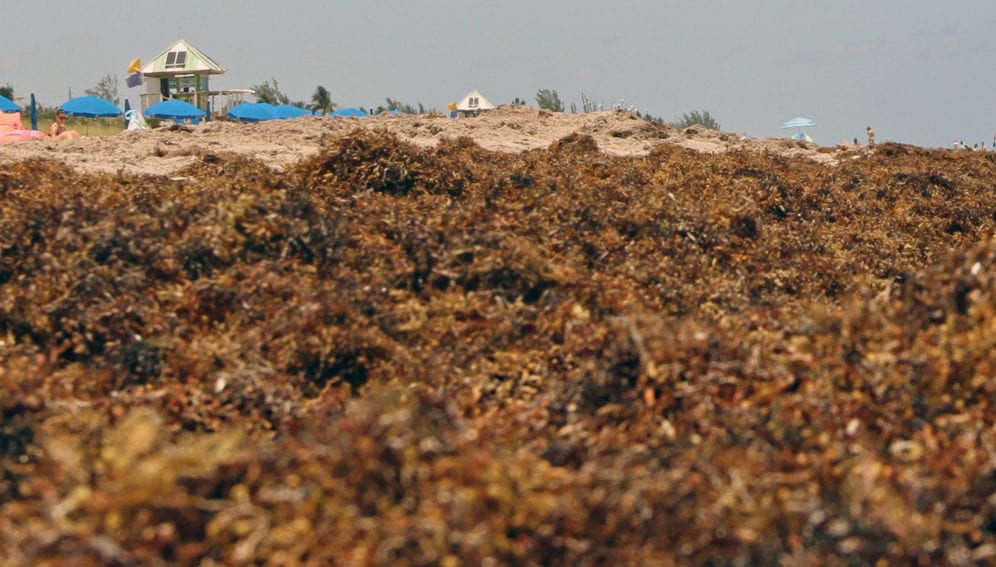Send to a friend
The details you provide on this page will not be used to send unsolicited email, and will not be sold to a 3rd party. See privacy policy.
Sargassum is a macroalgae that floats in patches in the ocean. In moderate quantities it is beneficial for the ocean’s health, providing habitat for turtles, crabs, fish and birds, and producing oxygen for photosynthesis.
“This is much more than just an economic or touristic problem. It is an environmental problem, with huge dimensions, and can’t be ignored,”
Esteban Amaro, Sargassum Monitoring Network, Cancun.
However, in larger quantities it can smother corals, trap sealife and wash up on beaches, releasing a foul-smelling gas. And the vast mass of Sargassum currently afflicting the Caribbean Basin is having a huge impact on coastal populations, tourism and ecosystems.
From a couple of tonnes of sargassum detected in 2011, when it started unexpectedly to emerge in the Central Atlantic, the mass grew to 20 million tonnes in June 2018, according to a study published in Science magazine (July 4), which analysed satellite images.
In a high-level meeting held late June in Cancun, Mexico, representatives from 13 countries in the region, including Mexico, Guatemala, Jamaica and Honduras, agreed 26 actions to address the problem.

One of those is the creation of the website internationalsargassumsystem.com, which will gather research and monitoring data on the seaweed.
Esteban Amaro, technical director of the Sargassum Monitoring Network in Cancun, told SciDev.Net that sargassum is a “relatively new problem,” and more research is needed, with only limited information currently available.
Turtles, coral at risk
One of the effects observed by scientists to date is the impact on coral, said Amaro, adding: “In field work we have seen a very high coral mortality, because of white syndrome (a disease which kills coral tissue)”.
It is believed that the disease is caused by a bacteria linked to a high presence of sargassum, although it has not been scientifically proven. Fish and sea turtles may also be dying as a result, though again scientific evidence is lacking.
The study in Science showed that not only are millions of tonnes of sargassum emerging in the Central Atlantic, their bloom patterns are also changing. In Latin America, the seaweed is even reaching the mouth of the Amazon.



Chuanmin Hu, a researcher from the University of South Florida, in the United States, and lead author of the study, said: “The ocean’s chemistry must have changed in order that the bloom has become uncontrolled in that way.”
According to Hu, factors contributing to the explosive bloom may include deforestation and use of fertilisers, which would cause the composition of the discharge that the Amazon River leaves in the ocean to change, turning it into a perfect breeding ground for sargassum.
‘Ecological imbalance’
Brigitta van Tussenbroek, a researcher from the Puerto Morelos Academic Unit of Reef Systems, of the National Autonomous University of Mexico, told SciDev.Net: “Any phenomenon that makes a population grow out of control will generate an ecological imbalance.
The excess of sargassum produces a lack of oxygen in the water, affecting other species and eventually killing them. However, its negative effect does not stop there.
When it decomposes, and gets stuck along the coast, “this organic material is transported again into the sea, which translates into an abnormal discharge of nutrients that goes way beyond the coast,” van Tussenbroek explained.And the problem appears to be getting worse. In 2018, on Mexico’s Quintana Roo coastline, 170,000 tonnes of sargassum arrived, while this year more than a million tonnes are expected.
“This is much more than just an economic or touristic problem. It is an environmental problem, with huge dimensions, and can’t be ignored,” said Amaro.
This article was produced by SciDev.Net’s Latina America and Caribbean desk and edited for clarity.














